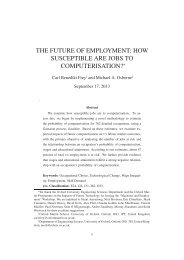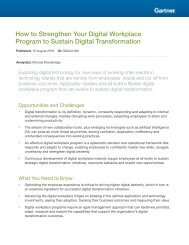THE FUTURE OF EMPLOYMENT: HOW SUSCEPTIBLE ARE JOBS TO COMPUTERIZATION?
We examine how susceptible jobs are to computerization. To assess this, we begin by implementing a novel methodology to estimate the probability of computerization for 702 detailed occupations, using a Gaussian process classifier. Based on these estimates, we examine expected impacts of future computerization on US labor market outcomes, with the primary objective of analyzing the number of jobs at risk and the relationship between an occupation’s probability of computerization, wages and educational attainment. According to our estimates, about 47 percent of total US employment is at risk. We further provide evidence that wages and educational attainment exhibit a strong negative relationship with an occupation’s probability of computerization.
We examine how susceptible jobs are to computerization. To assess this, we begin by implementing a novel methodology to estimate the probability of computerization for 702 detailed occupations, using a Gaussian process classifier. Based on these estimates, we examine expected impacts of future computerization on US labor market outcomes, with the primary objective of analyzing the number of jobs at risk and the relationship between an occupation’s probability of computerization, wages and educational attainment. According to our estimates, about 47 percent of total US employment is at risk. We further provide evidence that wages and educational attainment exhibit a strong negative relationship with an occupation’s probability of computerization.
You also want an ePaper? Increase the reach of your titles
YUMPU automatically turns print PDFs into web optimized ePapers that Google loves.
Oldenski, L. (2012). Offshoring and the polarization of the US labor market.<br />
Tech. Rep., Technical report, Mimeo, Georgetown University.<br />
Osborne, M.A., Garnett, R., Swersky, K. and de Freitas, N. (2012). Prediction<br />
and fault detection of environmental signals with uncharacterised faults. In:<br />
Twenty-Sixth AAAI Conference on Artificial Intelligence (AAAI-12).<br />
Phua, C., Lee, V., Smith, K. and Gayler, R. (2010). A comprehensive survey of<br />
data mining-based fraud detection research. arXiv preprint arXiv:1009.6119.<br />
Picard, R.W. (2010). Affective computing: from laughter to IEEE. Affective<br />
Computing, IEEE Transactions on, vol. 1, no. 1, pp. 11–17.<br />
Pissarides, C.A. (2000). Equilibrium unemployment theory. MIT press.<br />
Plötz, T. and Fink, G.A. (2009). Markov models for offline handwriting recognition:<br />
a survey. International Journal on Document Analysis and Recognition<br />
(IJDAR), vol. 12, no. 4, pp. 269–298.<br />
Rasmussen, C.E. and Nickisch, H. (2010). Gaussian processes for machine<br />
learning (GPML) toolbox. The Journal of Machine Learning Research,<br />
vol. 11, pp. 3011–3015.<br />
Rasmussen, C.E. and Williams, C.K.I. (2006). Gaussian Processes for Machine<br />
Learning. MIT Press.<br />
Ricardo, D. (1819). The principles of political economy and taxation. World<br />
Scientific.<br />
Robotics-VO (2013). A Roadmap for US Robotics. From Internet to Robotics.<br />
2013 Edition. Robotics in the United States of America.<br />
Roy, A.D. (1951). Some thoughts on the distribution of earnings. Oxford Economic<br />
Papers, vol. 3, no. 2, pp. 135–146.<br />
Saha, B., Goebel, K., Poll, S. and Christophersen, J. (2007). An integrated<br />
approach to battery health monitoring using Bayesian regression and state<br />
estimation. In: Autotestcon, 2007 IEEE, pp. 646–653. IEEE.<br />
55





